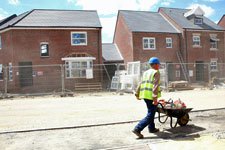 The government is on track to miss targets to reduce carbon emmissions, according to a report by the Committee on Climate Change (CCC). Under the current rate of progress, the UK will only reduce its carbon emissions by 21-23% between 2013 and 2025.
The government is on track to miss targets to reduce carbon emmissions, according to a report by the Committee on Climate Change (CCC). Under the current rate of progress, the UK will only reduce its carbon emissions by 21-23% between 2013 and 2025.
The committee blames the shortfall on the government’s policies for residential energy efficiency – the Green Deal and the Energy Company Obligation (ECO). It suggests government needs to simplify and rationalise these policies, which account for a large part of the UK’s ability to cut emissions.
The Green Deal – introduced in January last year to offer 25-year loans to pay for energy saving measures – has long been criticised for failing to attract a significant uptake due to high costs, with loan interest rates of around 7%.
According to the CCC, more than 200,000 Green Deal assessments have been carried out but only 2,500 Green Deal Finance plans have been signed, contributing to the limited levels of progress in energy efficiency.
ECO was introduced alongside the Green Deal to offer free solid wall insulation to low-income homes. However, it was changed by the current government, lowering ambitions with far less obligation on the companies, resulting in the limited progress in solid wall insulation.
The report shows that loft insulation rates decreased by 92% in 2013, to just under 130,000 installations. Cavity wall insulation also saw major reductions in installations, with just 170,000 in 2013, down from 500,000 average per year during the first carbon budget period, as households failed to take up the Green Deal.
Despite the introduction of the Renewable Heat Incentive (RHI), the rate of low-carbon heat uptake is unlikely to reach the government’s ambition of 12% of low-carbon heat demand in 2020. The committee sees the RHI as a realistic delivery mechanism for the forseeable future, yet uncertainty over RHI must be reduced. The CCC criticised the government for its lack of renewable energy target beyond 2020. It suggests funding for RHI should be pledged to 2020 as its current 2016 commitment undermines incentives for supply chain development.
Lord Deben, chairman of the CCC, said:
“Climate change demands urgent action. We have started on the road and we are being joined by much of the rest of the world. However, despite our success, the UK is still not on track to meet our statutory commitment to cut emissions by 80%. The longer we leave it, the costlier it becomes.”
The committee concluded that carbon budgets can be met at affordabe costs, but it will require the strengthening of key policies.




